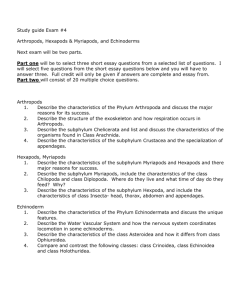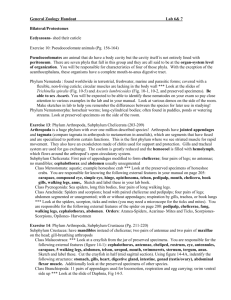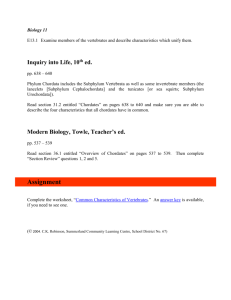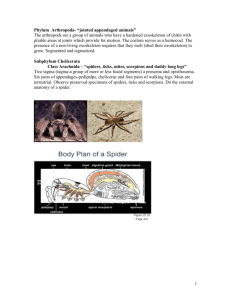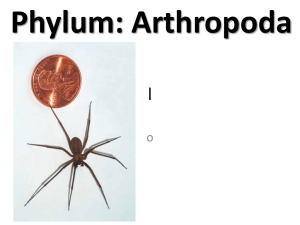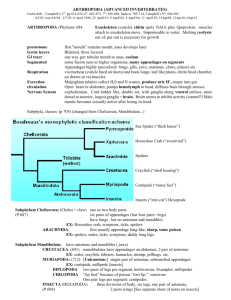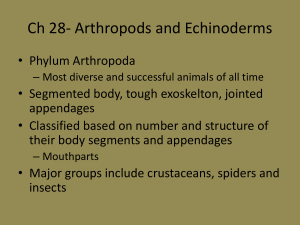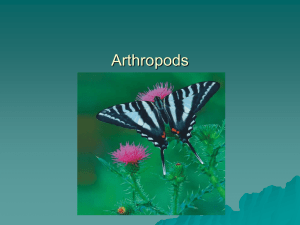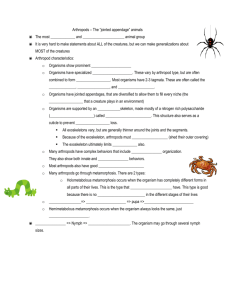Arthropods and Echinoderms
advertisement
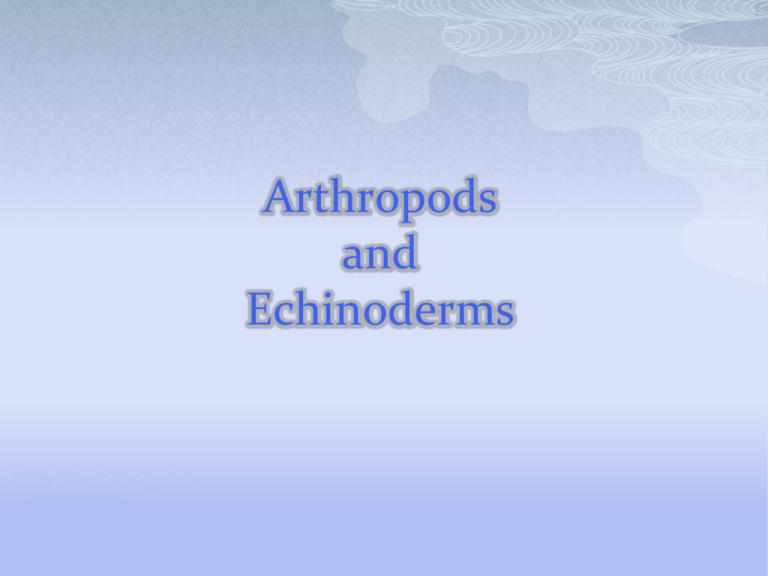
Arthropods and Echinoderms Phylum Arthropoda Most diverse phylum Most successful of all time About 1 million species have been identified = more than 3 times the number of all other animal species combined!! What is an Arthropod Includes insects, crabs, centipedes, and spiders All have segmented bodies, tough exoskeletons, and jointed appendages Exoskeletons Provide protection and support Made of protein and carbohydrate called chitin Vary in shape, size and toughness Terrestrial arthropods have waxy covering to prevent water loss Appendages Appendages: structures such as legs and antennae that extend from the body wall All are jointed Include antennae, claws, walking legs, wings, flippers, mouthparts, tails, and other specialized structures Named for this: arthron means “joint” in Greek, and podos means “foot” Evolution of Arthropods First arthropods appeared in the sea more than 600 million yrs. Ago Live in every habitat on Earth: sea, freshwater, land, and air Evolution has led to fewer body segments and highly specialized appendages for feeding, movement, and other functions Form and Function Use complex organ systems Feeding: herbivores, carnivores, and omnivores Bloodsuckers, filter feeders, detritivores, and parasites Mouthparts modified for chewing, sponging, sucking, and probing Form and Function Respiration Terrestrial arthropods breathe through network of branching tracheal tubes that extend throughout the body Air enters and leaves the tubes through spiracles: small openings located on outside of body Spiders have book lungs: organs with layers of respiratory tissues stacked like a book Aquatic arthropods use featherlike gills or book gills Form and Function Open circulatory system Well-developed heart pumps blood through arteries that branch and enter the tissues Leaves vessels moves through sinuses or cavities Collects in large sinus surrounding heart Re-enters heart and is again pumped through body Form and Function Excretion Terrestrial arthropods use malpighian tubules: saclike organs that extract wastes from the blood and then add them to feces that move through the gut Aquatic arthropods use diffusion to move cellular wastes from the body to the water Form and Function Well developed nervous systems Have brains that receive information and send it out to muscles Two nerves connect brain to a ventral nerve cord Along nerve cord are several ganglia that coordinate movements of individual legs and wings Sophisticated sense organs: compound eyes may have more than 2000 separate lenses to detect color and motion very well Form and Function Movement by well-developed groups of muscles made of individual muscle cells that contract and pull on exoskeleton At each joint, different muscles either flex or extend Form and Function Reproduction Terrestrial arthropods have internal fertilization Some put sperm inside female, others deposit sperm packet that female picks up Aquatic arthropods may have internal or external fertilization Growth and Development Exoskeleton does not grow, must be shed as arthropod gets bigger Molting: shedding of entire exoskeleton and making a new one Controlled by hormones Can take several hours Makes them vulnerable to predators while shell is still soft Most hide during molting or molt at night Groups of Arthropods Arthropods are classified based on the number and structure of their body segments and appendages – particularly their mouthparts Subphylum Crustacea Mostly aquatic Includes crabs, shrimps, lobsters, crayfishes, and barnacles Range in size from small terrestrial pill bugs to enormous spider crabs up to 20 kilograms Typically have 2 pairs of antennae, 2 or 3 body sections, and chewing mouthparts called mandibles Subphylum Crustacea Cephalothorax: anterior, fusion of head with the thorax Thorax: holds internal organs Abdomen: posterior part of the body Carapace: part of the exoskeleton covering the cephalothorax Subphylum Crustacea 1st 2 pairs of appendages are antennae covered in sensory hairs Used as sensory organs, filter-feeding, or swimming 3rd pair are the mandibles adapted for biting and grinding food Gills are attached to appendages associated with the cephalothorax Subphylum Crustacea Decapods: crayfish, lobsters, and crabs Largest group of crustaceans Five pairs of legs 1st pair of legs called chelipeds, bear large claws modified to catch, pick up, crush and cut food 4 pairs of walking legs Along abdomen are several pairs of swimmerets: flipperlike appendages used for swimming Final abdominal segment is fused to form a large, flat tail: uropod Subphylum Chelicerata Includes horseshoe crabs, spiders, ticks, and scorpions Have mouthparts called chelicerae and two body segments and 4 pairs of walking legs No antennae Cephalothorax contains brain, eyes, mouth, and walking legs Abdomen contains internal organs Subphylum Chelicerata Chelicerae contain fangs used to stab and paralyze prey Pedipalps used to grab prey Respire with either book gills or book lungs Two main classes: Merostomata and Arachnida Subphylum Chelicerata Class Merostomata Includes horseshoe crabs Oldest living arthropods: first appeared 500 mya Not true crabs at all Anatomy similar to spiders Have chelicerae, five pairs of walking legs, and long spikelike tail Can grow to size to frying pan Common along eastern US coast Subphylum Chelicerata Spiders: largest group of arachnids Capture food in a variety of ways: webs made of protein called silk, stalk and pounce on prey (turantula), lie in wait then grab Feed on animals ranging from other arthropods to small birds No jaws for chewing, must liquefy food to swallow it Subphylum Chelicerata Once prey is caught, fangs inject paralyzing venom Once prey is dead, spider injects digestive enzymes into the wounds Spider sucks out tissues into a specialized pumping stomach Food then moves to the rest of the digestive tract being further broken down by enzymes Subphylum Chelicerata All spiders produce silk even if they don’t spin webs Stronger than steel! Used for webs, cocoons for eggs, wrappings for prey Force liquid silk through spinnerets: organs that contain silk glands As silk comes out it hardens into single strand Spinning webs seems to be preprogrammed behavior Subphylum Chelicerata Mites and Ticks: small and often parasitic Specialized chelicerae for piercing tissue and sucking out blood Pedipalps are often equipped with claws for holding on to host Parasitize plants and animals Can cause itching, painful rashes, and transmit diseases such as Rocky Mtn. spotted fever and Lyme disease Subphylum Chelicerata Scorpions: widespread in warm areas including southern US Pedipalps enlarged into claws Long, segmented abdomen has a venomous stinger that can kill or paralyze prey Chew up prey with chelicerae Subphylum Uniramia Includes centipedes, millipedes, and insects Response to stimuli Compound eyes Chemical receptors for taste and smell on mouthparts, antennae and legs Sensory hairs to detect movement Well-developed ears that hear above human range; found in strange places (behind legs in grasshoppers) Subphylum Uniramia Adaptations for feeding 3 pairs of appendages for mouthparts including mandibles Saliva contains digestive enzymes Bee saliva help change nectar into honey Glands in bee’s abdomen secrete wax, used to build beehives Subphylum Uniramia Movement and Flight Legs used for jumping, walking, capturing and holding prey Flying insects usually have two pairs of wings made of chitin Flight has allowed for movement worldwide and wide variety of habitats Subphylum Uniramia Metamorphosis: process of changing shape and form 2 types: incomplete and complete Incomplete metamorphosis: gradual change with nymph immature forms Nymphs lack sexual organs and wings and usually look similar to the adult form Complete metamorphosis: dramatic change with larval stage and pupa Insect Communication Use sound, visual, chemical, and other types of signals Most communication is for mating Sound: crickets chirping by rubbing legs together; cicadas buzz by vibrating special membranes on their abdomens Visual cues: fireflies lighting up Chemical signals: pheromones used for alarm or alerting other insects and for mating Insect Societies Ants, bees, termites, and some of their relatives form complex associations called societies Societies work together for the benefit of the whole group Can have more than 7 million individuals Castes: groups of individuals performing a certain job or role in the society (queen, workers, drones, etc) Classification for Subphylum Uniramia Centipedes: Class Chilopoda Millipedes: Class Diplopoda Insects: Class Insecta Order Orthoptera: Crickets, grasshoppers, locusts Order Isoptera: termites Order Hymenoptera: bees, wasps, and ants Order Lepidoptera: butterflies and moths Order Diptera: true flies Order Coleoptera: beetles Order Hemiptera: true bugs Order Anoplura: human louse (lice) Order Odonata: dragonflies Order Dictyoptera: cockroaches and mantids
